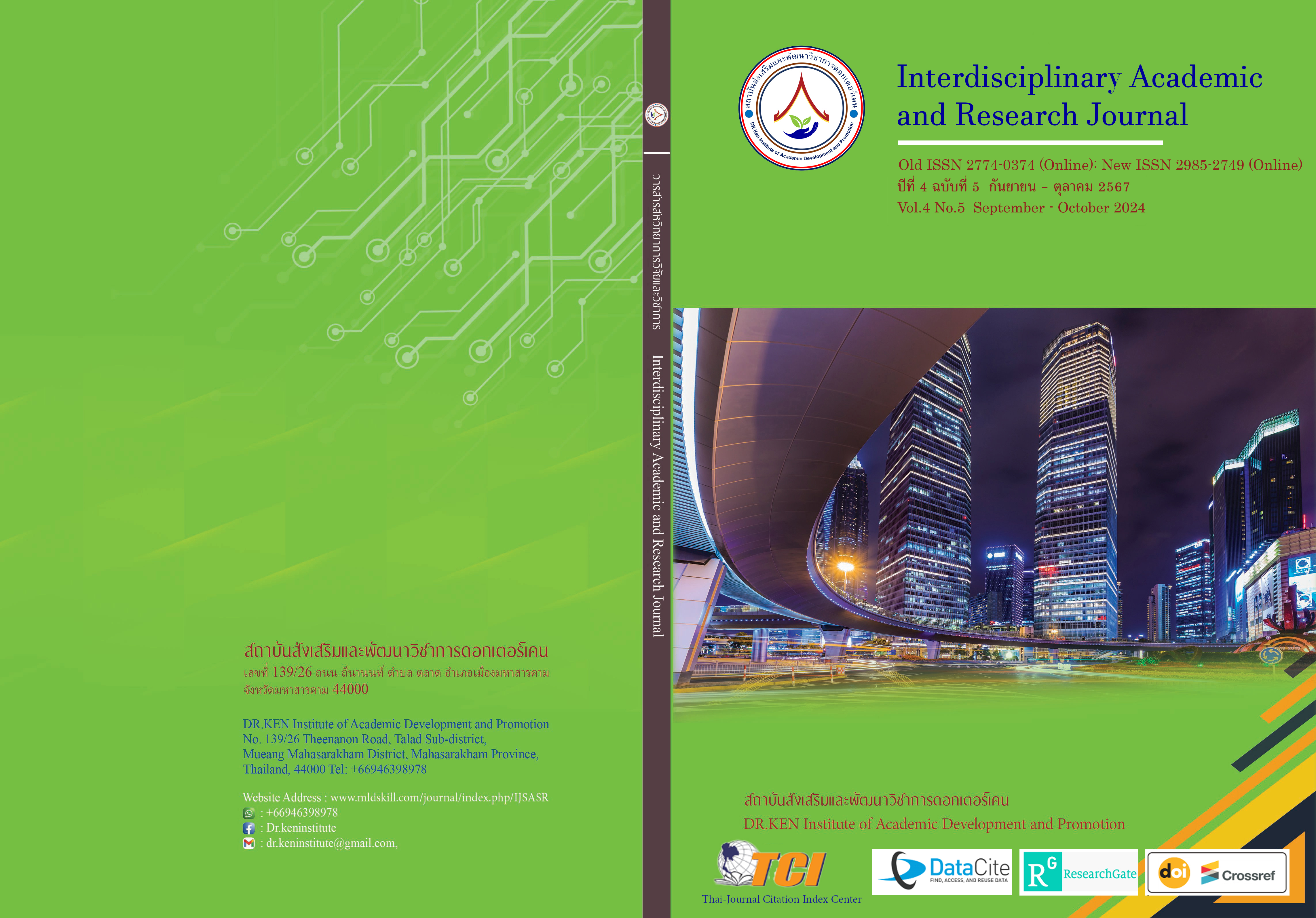Promoting the use of School Curriculum under the Jurisdiction of Saraburi Primary Educational Service Office Area 2
DOI:
https://doi.org/10.60027/iarj.2024.277050Keywords:
Curriculum Using Promoting;, School CurriculumAbstract
Background and Aims: The purposes of this research are to: (1) study the level of promotion of the use of the curriculum of educational institutions under the Saraburi Primary Educational Service Office Area 2. (2) Compare the level of opinions of personnel regarding promoting the use of the curriculum in educational institutions under the jurisdiction of the Saraburi Primary Educational Service Office Area 2, divided by position. Size of the educational institution and work experience. (3) Study guidelines for developing and promoting the use of the curriculum of educational institutions under the Saraburi Primary Educational Service Office Area 2.
Methodology: The sample group in this research consisted of 317 personnel from educational institutions under the Saraburi Primary Educational Service Office Area 2, which were obtained from stratified random sampling. The tool used to collect data was a questionnaire with an IOC between 0.80 – 1.00. And had a reliability value of 0.91 including a structured interview. Statistics used in data analysis include frequency, percentage, mean, standard deviation, t-test statistic, and F-test statistic.
Results: The results of the research found that: (1) promoting the use of the curriculum in educational institutions Under the jurisdiction of the Saraburi Primary Educational Service Office Area 2, overall and each aspect is at a high level. When considering each aspect, it was found that Promotion of the use of the curriculum in all aspects is also at a high level. (2) Comparison of promoting the use of the curriculum of educational institutions classified by position size of the educational institution and work experience found that there were no significant differences. (3) Guidelines for promoting the use of the curriculum in educational institutions. It was found that educational institutions should set guidelines for personnel to check the consistency of the curriculum. There are workshops on how to use the curriculum. Establish an academic center to support and promote the use of the curriculum. Including training in developing measurement and evaluation tools. along with continuously checking the effectiveness of the quality of the curriculum.
Conclusion: Within the Saraburi Primary Educational Service Office Area 2, the assessment found that the educational institution's commitment to the curriculum is commendable. Demonstrate a deep understanding of all dimensions of curriculum use. The analysis also highlights consistency in promoting the use of the curriculum across educational contexts, with a focus on consistent policies and supporting frameworks. To guarantee the effectiveness and maintain the quality of operations.
References
จักรพรรดิ์ ชื่นภิรมย์. (2565). การบริหารจัดการหลักสูตรสถานศึกษาของสถานศึกษาในสังกัดสำนักงานเขตพื้นที่การศึกษามัธยมศึกษาอุบลราชธานี อำนาจเจริญ. ศึกษาศาสตรมหาบัณฑิต สาขาวิชาการบริหารการศึกษา, วิทยาลัยนครราชสีมา. นครราชสีมา.
ชนาพร เมฆดี. (2565). การศึกษาสภาพและแนวทางการบริหารหลักสูตรสถานศึกษา สังกัดสำนักงานเขตพื้นที่การศึกษามัธยมศึกษา ในจังหวัดพิษณุโลก. Journal of Roi Kaensarn Academi, 7(4), 160 – 173.
ทรายทอง ใฝ่ขันติ. (2566). การบริหารหลักสูตรสถานศึกษาของโรงเรียนในอำเภอบ้านธิ สังกัดสำนักงานเขตพื้นที่การศึกษาประถมศึกษาลำพูน เขต 1. วารสาร มมร วิชาการล้านนา, 12(1), 48 – 58.
นิตยา สุริน. (2565). การพัฒนาศักยภาพบุคลากรในการเปลี่ยนสู่ยุคดิจิทัล : กรณีศึกษาสำนักงานเลขานุการคณะกรรมการวินิจฉัยชี้ขาดอำนาจหน้าที่ระหว่างศาล สำนักงานศาลยุติธรรม. รัฐประศาสนศาสตรมหาบัณฑิต, มหาวิทยาลัยรามคำแหง. กรุงเทพฯ.
บุญชม ศรีสะอาด. (2556). การวิจัยเบื้องต้น. พิมพ์ครั้งที่ 9. กรุงเทพฯ : สุวรียาสาส์น.
พัชรินทร์ ศิริสุข. (2563). การประเมินผลโครงการส่งเสริมสนับสนุนการพัฒนาหลักสูตรสถานศึกษา โรงเรียนวัดใหม่ช่องลม สังกัดกรุงเทพมหานคร คุรุสภาวิทยาจารย์. วารสารเพื่อการพัฒนาวิชาชีพครู, 1(3), 109 – 119.
มงคล หมู่มาก. (2560). การเสริมสร้างสมรรถภาพการพัฒนาหลักสูตรและออกแบบการเรียนรู้อิงมาตรฐาน สำหรับบุคลากรในสถานศึกษาขั้นพื้นฐาน. วารสารครุศาสตร์ คณะครุศาสตร์ มหาวิทยาลัยราชภัฏกำแพงเพชร, 2(4), 28 – 44.
ยุทธชัย ราชดา. (2566). แนวทางการพัฒนาหลักสูตรสถานศึกษาโดยใช้การมีส่วนร่วมสำหรับโรงเรียนขยายโอกาสทางการศึกษา สังกัดสำนักงานเขตพื้นที่การศึกษาประถมศึกษามหาสารคาม เขต 3. วารสารพุทธปรัชญาวิวัฒน์, 7(1), 651 – 665.
ศิวะลักษณ์ มหาชัย. (2565). การพัฒนาหลักสูตรสถานศึกษา. วารสารมณีเชษฐาราม วัดจอมมณี, 5(2), 168 – 185.
สงกรานต์ เรืองประทีป. (2559). การบริหารหลักสูตรสถานศึกษา โรงเรียนสังกัดสำนักงานเขตพื้นที่การศึกษามัธยมศึกษา เขต 4. วิทยานิพนธ์ ปริญญาศึกษาศาสตรมหาบัณฑิต สาขาวิชาการบริหารการศึกษา, คณะครุศาสตร์อุตสาหกรรม, มหาวิทยาลัยเทคโนโลยีราชมงคลธัญบุรี. ปทุมธานี.
อวัศยา แสงทอง. (2564). การพัฒนาหลักสูตรสถานศึกษาของโรงเรียนวัดจันทราวาส (ศุขประสารราษฎร์). กรุงเทพฯ: ศึกษาศาสตรมหาบัณฑิต สาขาวิชาการบริหารการศึกษา, มหาวิทยาลัยศิลปากร.
Beauchamp. G.A. (1975). Curriculum Theory. 3rd ed. Wilmette Illinois: The Kagg Press.
Krejcie, R. V., & Morgan, D. W. (1970). Determining sample size for research activities. Educational and Psychological Measurement, 30(3), 607–610. DOI: https://doi.org/10.1177/001316447003000308
Downloads
Published
How to Cite
Issue
Section
License
Copyright (c) 2024 Interdisciplinary Academic and Research Journal

This work is licensed under a Creative Commons Attribution-NonCommercial-NoDerivatives 4.0 International License.
Copyright on any article in the Interdisciplinary Academic and Research Journal is retained by the author(s) under the under the Creative Commons Attribution-NonCommercial-NoDerivatives 4.0 International License. Permission to use text, content, images, etc. of publication. Any user to read, download, copy, distribute, print, search, or link to the full texts of articles, crawl them for indexing, pass them as data to software, or use them for any other lawful purpose. But do not use it for commercial use or with the intent to benefit any business.
















.png)


